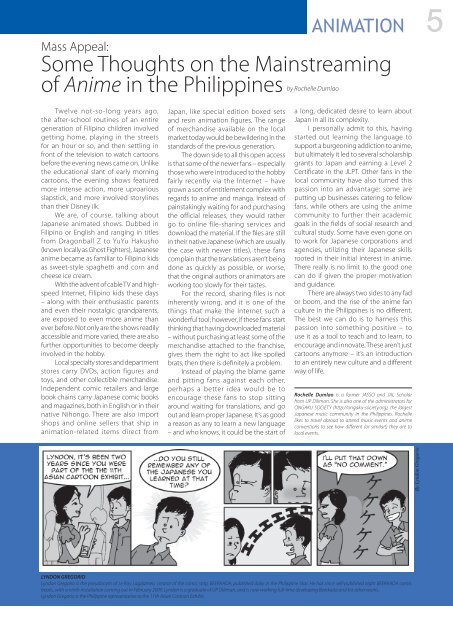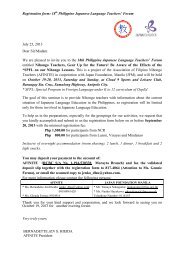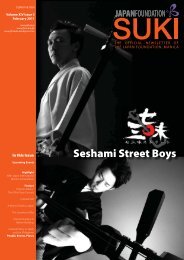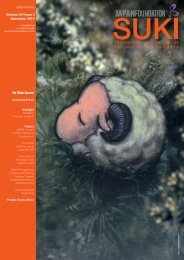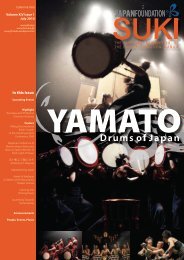HIGHLIGHT>> FROM PAGE 3regardless of race, gender, or age. Whilematerial deprivation is most obvious in allcases what stays are images of isolation,despair and humiliation. When povertystrikes it robs people of their dignity andhonor as human beings. No one was bornonly to become homeless or hungry.Poverty is the antithesis to the honor ofhuman life. But to see these images in <strong>Japan</strong>was truly something else. Our reactions todiscovering homeless or hungry peoplein <strong>Japan</strong> ranged from surprise to disbelief,from pity to compassion, from confusionto compulsion to act. Our journey into <strong>this</strong>strange world was made comprehensibleby the invaluable companionship of thosewho have gone ahead of us, the NPO’s andtheir dedicated leaders. <strong>The</strong>y acceptedsuch reality when very few of their ownpeople were even aware, they took on thechallenge of responding to their needswhile most of <strong>Japan</strong> cared too little to evenknow more about it.But our initiation into the world of thepoor was brought to its greatest heightwhen we were made to understand itsmachinery. It all starts with joblessness andfrom there a chain reaction is triggered thatcause people to fall into the cracks of anotherwise effective <strong>Japan</strong>ese social securitysystem. <strong>In</strong> discussing the plight of the poor,our lecturers inevitably revealed to us theunique workings and intimate connectionsof employment and life in <strong>Japan</strong>. Equallyshocking to the reality of poverty was theprinciple of life-long employment. Andnow that <strong>this</strong> system is being shaken by therealities of modern economics and currentrecession it is wreaking havoc in the livesof those who lose their jobs, specially theolder men. Being jobless is the first stepto a series of misfortunes that being bybeing on welfare to being homeless tobeing hungry. And somewhere along theway the poor in <strong>Japan</strong> becomes isolated.<strong>The</strong> lack of alternative support systems(family, friends, NPO’s) was a start void thatmost of us took notice of. Why were theseabsent? This question then led us to therealities that compounded the situation:declining family ties, job-centered lives,meritocracy and materialism, a civil societythat was never needed, a governmentthat provided everything to the point ofcreating dependency and dampening civilempowerment.This aspect of our trip was bothsaddening but also hopeful. We tried toJENESYS participants discussing with <strong>Japan</strong>ese people regarding their welfare in Kotobuki-cho, Yokohama.see beyond the details and read betweenthe lines. Our alarm and concern for therising incidence of poverty was met withthe dynamism of ideas and prospectsfor change. We drew hope from the fewwho dared to rise up to the challenge.Our forays into the unpopular realmsof <strong>Japan</strong> brought with it the privilegeof meeting the remarkable men andwomen at the frontiers the battle againstpoverty in <strong>Japan</strong>. It is their passion anddedication that triggered our ideas andhopes. So long as they are there thepoor in <strong>Japan</strong> will never be truly alone.Our brief encounters were simply notenough to forge plans but was definitelyenough to lay the foundations for futurecollaboration. It is our hope that ourencounters provided our <strong>Japan</strong>ese NPOcounterparts with hope, inspiration, andperspective that they are not alone in thebattle that they are fighting, that theyhave a companions in the 16 countrieswho were present. <strong>The</strong> key to survivingthese rough times is to stay together andto not leave anyone behind. That in thesetrying times, it is not just governmentwho is to be trusted (or blamed?) for asolution but that every <strong>Japan</strong>ese citizenis involved and can make a difference ifgiven the inspiration, chance, and supportto make it happen. Somehow, in betweenthe cracks of <strong>this</strong> faltering economicsystem there is a resounding desire towork together, to be in community, asin the spirit of the mura, as the first steptowards a better <strong>Japan</strong>.Finally, the trip gave us somethingbeyond <strong>Japan</strong>. It gave us the gift offriendship from 16 countries. While mostof the trip was spent on knowing <strong>Japan</strong>,in between the tightly knit schedule wealso had the opportunity to glimpse intothe world of other countries. <strong>In</strong> <strong>this</strong> trip,I began seeing beyond my own country.Almost comically, a sinking ship in <strong>Manila</strong>now matters to my friend from Australiasimply because I might be on that boat!Or if Thailand elects a new PM, it nowmatters to me because it may spell thedifference between being able to land ornot land in Bangkok. Simply put, foreignaffairs have become personal concernsfor each of the 20 participants. <strong>Japan</strong> isfamous in my country for building a lotof bridges and roads. And I think it didthe same thing for me during <strong>this</strong> trip.<strong>The</strong> JENESYS program put me on anexpressway into understanding <strong>Japan</strong>and its challenges on poverty but it alsoopened up side roads and detours intothe world my Asian neighbors. And it wasa great privilege to meet the best fromthese countries, the future leaders of Asia.And no matter how small and partiallysignificant we are right now we hope thatwe live up to our destiny of being futureleaders and really make the difference thathas long been spoken. And forging theseconnections could not have come at abetter time. It is very important to rekindle<strong>this</strong> connection in a setting of an impedingonce-in-a-century global economic crisis.This crisis was triggered by a sophisticatedform of greed and propelled by fear. Andpeople the world over are just so afraidand insecure. But as we build bridges androads of understanding and friendship wesomehow feel less afraid because of theassurance that we are not alone. Somehowin doing what each of us are doing forour own countries we feel that we canask our friends in Asia and Oceania forsupport and encouragement. Becauseof <strong>this</strong> trip we are beginning to see <strong>this</strong>corner of <strong>this</strong> world as our neighborhood,our community, and in so many waysmaybe one big little Asia-mura.*Mura means a village in <strong>Japan</strong>ese language.Mark Lawrence Cruz is a coordinator of Gawad Kalinga-Ateneo Coordinating Office; and participant for JENESYS Program on “Overcoming Poverty through a Social inclusion Approach:<strong>The</strong> Status Quo of Asia and Oceania in a Globalized Economy” (December 9-19, 2008).
Mass Appeal:ANIMATIONSome Thoughts on the Mainstreamingof Anime in the Philippines by Rochelle DumlaoTwelve not-so-long years ago,the after-school routines of an entiregeneration of Filipino children involvedgetting home, playing in the streetsfor an hour or so, and then settling infront of the television to watch cartoonsbefore the evening news came on. Unlikethe educational slant of early morningcartoons, the evening shows featuredmore intense action, more uproariousslapstick, and more involved storylinesthan their Disney ilk.We are, of course, talking about<strong>Japan</strong>ese animated shows. Dubbed inFilipino or English and ranging in titlesfrom Dragonball Z to YuYu Hakusho(known locally as Ghost Fighters), <strong>Japan</strong>eseanime became as familiar to Filipino kidsas sweet-style spaghetti and corn andcheese ice cream.With the advent of cable TV and highspeed<strong>In</strong>ternet, Filipino kids these days– along with their enthusiastic parentsand even their nostalgic grandparents,are exposed to even more anime thanever before. Not only are the shows readilyaccessible and more varied, there are alsofurther opportunities to become deeplyinvolved in the hobby.Local specialty stores and departmentstores carry DVDs, action figures andtoys, and other collectible merchandise.<strong>In</strong>dependent comic retailers and largebook chains carry <strong>Japan</strong>ese comic booksand magazines, both in English or in theirnative Nihongo. <strong>The</strong>re are also importshops and online sellers that ship inanimation-related items direct from<strong>Japan</strong>, like special edition boxed setsand resin animation figures. <strong>The</strong> rangeof merchandise available on the localmarket today would be bewildering in thestandards of the previous generation.<strong>The</strong> down side to all <strong>this</strong> open accessis that some of the newer fans – especiallythose who were introduced to the hobbyfairly recently via the <strong>In</strong>ternet – havegrown a sort of entitlement complex withregards to anime and manga. <strong>In</strong>stead ofpainstakingly waiting for and purchasingthe official releases, they would rathergo to online file-sharing services anddownload the material. If the files are stillin their native <strong>Japan</strong>ese (which are usuallythe case with newer titles), these fanscomplain that the translations aren’t beingdone as quickly as possible, or worse,that the original authors or animators areworking too slowly for their tastes.For the record, sharing files is notinherently wrong, and it is one of thethings that make the <strong>In</strong>ternet such awonderful tool; however, if these fans startthinking that having downloaded material– without purchasing at least some of themerchandise attached to the franchise,gives them the right to act like spoiledbrats, then there is definitely a problem.<strong>In</strong>stead of playing the blame gameand pitting fans against each other,perhaps a better idea would be toencourage these fans to stop sittingaround waiting for translations, and goout and learn proper <strong>Japan</strong>ese. It’s as gooda reason as any to learn a new language– and who knows, it could be the start ofa long, dedicated desire to learn about<strong>Japan</strong> in all its complexity.I personally admit to <strong>this</strong>, havingstarted out learning the language tosupport a burgeoning addiction to anime,but ultimately it led to several scholarshipgrants to <strong>Japan</strong> and earning a Level 2Certificate in the JLPT. Other fans in thelocal community have also turned <strong>this</strong>passion into an advantage: some areputting up businesses catering to fellowfans, while others are using the animecommunity to further their academicgoals in the fields of social research andcultural study. Some have even gone onto work for <strong>Japan</strong>ese corporations andagencies, utilizing their <strong>Japan</strong>ese skillsrooted in their initial interest in anime.<strong>The</strong>re really is no limit to the good onecan do if given the proper motivationand guidance.<strong>The</strong>re are always two sides to any fador boom, and the rise of the anime fanculture in the Philippines is no different.<strong>The</strong> best we can do is to harness <strong>this</strong>passion into something positive – touse it as a tool to teach and to learn, toencourage and innovate. <strong>The</strong>se aren’t justcartoons anymore – it’s an introductionto an entirely new culture and a differentway of life.Rochelle Dumlao is a former JASSO and JAL Scholarfrom UP Diliman. She is also one of the administrators forONGAKU SOCIETY (http://ongaku-society.org), the largest<strong>Japan</strong>ese music community in the Philippines. Rochellelikes to travel abroad to attend music events and animeconventions to see how different (or similar!) they are tolocal events.By Lyndon GregorioLYNDON GREGORIOLyndon Gregorio is the pseudonym of Le Roy Lagdameo, creator of the comic strip, BEERKADA, published daily in the Philippine Star. He has since self-published eight BEERKADA comicbooks, with a ninth installation coming out in February 2009. Lyndon is a graduate of UP Diliman, and is now working full-time developing Beerkada and his other works.Lyndon Gregorio is the Philippine representative to the 11th Asian Cartoon Exhibit.


